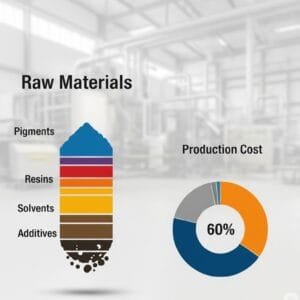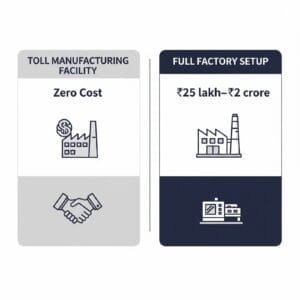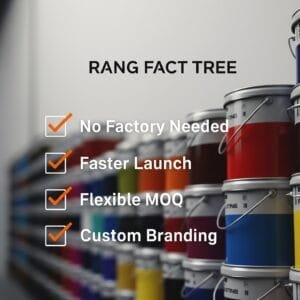The demand for paints and coatings in India and across the world is constantly rising—driven by booming construction, real estate development, home renovations, and increasing consumer interest in aesthetics. For new entrepreneurs looking to start a manufacturing business, paint manufacturing stands out as a potentially lucrative venture. But is it really profitable? Let’s explore the truth behind the numbers, the opportunities, and the challenges that come with starting a paint manufacturing business.
Understanding the Paint Manufacturing Industry
Paint manufacturing involves creating a range of paint products including emulsions, distempers, enamels, primers, and industrial coatings. The Indian paint industry is estimated to be worth over ₹62,000 crore (as of 2025), with both decorative and industrial segments showing steady growth.
Decorative paints (used in homes and buildings) contribute around 75% of the total market, while industrial paints (used in sectors like automotive, marine, machinery) make up the rest. Within decorative paints, emulsions are gaining popularity over distemper due to their durability, washability, and rich finish.
This growth indicates a solid demand base—but profitability depends on several key factors.
Is Paint Manufacturing Profitable?
1. High Demand = Strong Market Opportunity
From homeowners to construction companies, everyone needs paint. Urbanization, rising disposable incomes, and the “paint-your-home” festival trends in India create recurring demand.
Additionally, government infrastructure projects, smart cities, and affordable housing schemes drive the need for protective and decorative coatings—giving a consistent business opportunity to paint manufacturers.
Pro tip: Localized manufacturing with region-specific color choices and pricing strategies can give you a competitive edge.
2. Decent Margins with Proper Cost Control
While raw materials such as pigments, resins, solvents, and additives may account for 50-60% of your production cost, smart sourcing and formulation can improve profitability.
Profit margins in the paint manufacturing business range from 15% to 30%, depending on your business model (retail, bulk supply, B2B, white labeling).
Water-based paints like emulsions generally offer better margins than solvent-based paints.
If you go for toll manufacturing or white labeling, you reduce risk, eliminate R&D costs, and can still earn 10-20% per batch.
Smart tip: Keep an eye on global oil and chemical prices—they directly impact paint raw material costs.
3. Low Entry Barrier with White Labeling Models
A major advantage in today’s market is the availability of toll manufacturing or white labeling. New entrepreneurs can start their own paint brand without setting up a full factory.
Companies like Rang Fact Tree offer ready infrastructure and formulations where you provide branding, packaging, and marketing. This drastically lowers your startup investment and technical complexity.
Startup Investment: zero Investment (for white label model).
Factory Setup Model: ₹25 lakh to ₹2 crore depending on scale.
4. Scalability with Private Label Branding
Private label paint brands are gaining popularity—especially in Tier 2 and Tier 3 cities. You can start small and scale by adding variants like weather-proof paints, eco-friendly paints, and texture coatings.
As your brand grows, you can cater to:
Dealers & distributors
Architects and interior designers
Online marketplaces like Amazon, Flipkart, and your own D2C website
Digital marketing, influencer collaborations, and YouTube tutorials can also help promote your paint brand organically.
5. Challenges You Must Be Aware Of
Despite its profitability, paint manufacturing comes with challenges:
Regulatory approvals: You must adhere to BIS (Bureau of Indian Standards), pollution control norms, and safety standards.
Brand trust: Competing with established players like Asian Paints or Berger requires effort in building credibility.
Storage and shelf life: Paints have a limited shelf life and must be stored under proper conditions.
Technical knowledge: Even with toll manufacturing, you need to understand basic chemistry, mixing ratios, and application methods.
Key Tips for New Entrepreneurs
Start small, grow smart – Use a toll manufacturer for the first 6-12 months.
Focus on niche – Offer eco-friendly, low-VOC, or budget segment paints to build your brand in a focused category.
Invest in packaging – Good packaging builds trust and enhances shelf appeal.
Build relationships with dealers – Distributors and retail partners are critical to expanding reach.
Final Verdict: Yes, Paint Manufacturing Is Profitable—If Done Right
Paint manufacturing is not only profitable but also scalable. Whether you’re manufacturing in-house or launching a white-label paint brand, success depends on understanding the market, managing costs, and delivering quality.
With the right strategy, branding, and distribution model, even a small entrepreneur can build a sustainable paint business in India. As the demand for decorative and industrial paints continues to rise, this is the perfect time to explore this vibrant industry.
Before starting your next painting journey, consider making the switch. It’s not just paint—it’s innovation made simple.
📞 Contact Rang Facttree Today
Call us at 1800 309 6799 or visit www.rangfacttree.com / www.mithilapaints.com
Let us handle the factory—while you build your business






